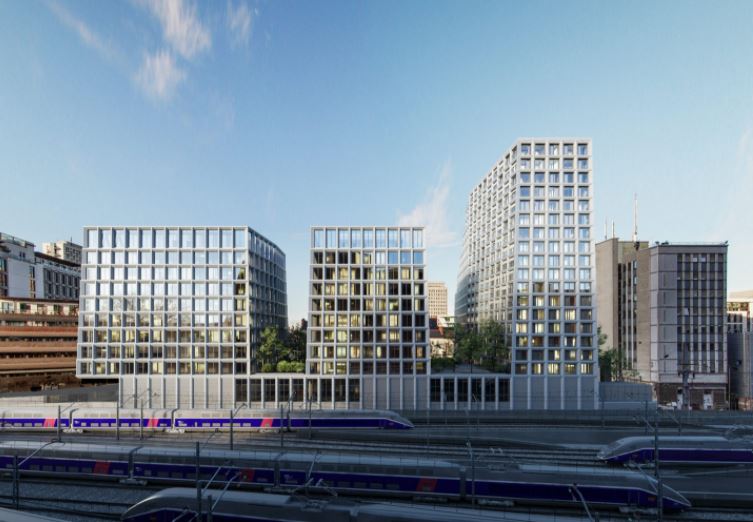
by Ron Bernthal
The Saint-Michel quarter has always been a transient place. Rennes’s history goes back more than 2,000 years, at a time when it was a small Gallic village named Condate. Together with Vannes and Nantes, Rennes was one of the major cities of the ancient Duchy of Brittany. In the Middle Ages, a chapel and priory were built over the ruins of the castle of the Counts of Rennes in the 12th century, on the site of the former Prison Saint-Michel, near the ramparts, and now located next to the present-day Place Rallier du Baty, a quaint district of Rennes with beautiful wood framed houses and cafes.

The site, on a hilltop overlooking the city, is dedicated to Saint Michael and the Rennes street and neighborhood (called Saint-Michel since the 15th-century), is in the city center, about a 12 minute bike ride north of Gare de Rennes, where the Beaumont EuroRennes project is creating a buzz in the region, and is one of Europe’s most vibrant, urban regeneration projects.
In conjunction with Rennes Métropole and Territoires Publics, Espaces Ferroviaires (a subsidiary of SNCF) launched a competition in 2017 for the design and development of the area’s Beaumont Block, a former industrial area near the main Rennes train station. In 2018, the competition jury selected the architectural firm of Atelier Kempe Thill (Rotterdam), associated with Atelier 56S (Rennes) and Dots Paysagiste (Paris), to design the new project.
In Rennes, July 2017 was marked by the arrival of the high-speed LGV train, making it possible to reach Paris in just 1:25 hours. Combined with the acceleration of the train station’s modernization, the entire site saw a real turning point in the transformation of the district and its surrounding environment.

Beginning in 2016 this urban landscape in the middle of Rennes began to be transformed, little by little, reflecting the dynamism of the EuroRennes development operation as a whole.

The EuroRennes district, with the new station, often called the “Gateway to Brittany,” has now become a place where the modern city of Rennes and the historic city of Rennes connect. Built around several building projects, including the Cité Internationale Paul Ricoeur (opened in 2016); the Congress Center (2018); the commissioning of the TGV high-speed line (2017); and the addition of the new Metro Line B (2022), Beaumont district’s transformation is influencing other new regeneration projects throughout the Rennes metropolitan area.

The Beaumont EuroRennes project site complex is located along the train tracks next to the Gare de Rennes, and covers almost 270,000 square-feet of building space. The project will include 240 housing units (rental, home ownership and managed residences), nearly 10,000 square-feet of retail space, and 129,000 square-feet of offices. The Beaumont Block is often defined as a “showcase” sector for the station hub, characterized a mixed-use character, including offices, residential housing, retail shops and services.

The Beaumont EuroRennes zone is under the scope of the adjacent development zone of 143 acres surrounding the Rennes train station, and will soon be a place for residential l ife and culture, as well as a thriving business district. This area is in the heart of the city, and is expected to reflect the coming changes throughout the district that will, in the coming years, extend the city center to the south, strengthening commercial and cultural activity within its area, and transforming the train station into a true Multimodal Exchange Hub in the heart of the city.

The soon to be opened Metro Line B is the impetus for a large number of Rennes real estate projects which have sprouted along the route of the new Metro line. The Beaumont EuroRennes city center projects allow for ongong redevelopment of new housing and the restoration of historic and traditional structures, with the Jacobins Convention Center as its modern heart. The opening of Rennes Metro Line B, the city’s second driverless, rubber-tire metro line will take place in early 2022.

A large part of the city’s revitalization is the Général de Gaulle esplanade, which has become an essential location in the life of the city. Beaumont EuroRennes is helping to create an enlarged and diversified city center, and a short distance away, in the eastern part of the city, the Baud-Chardonnet district is setting out to embellish the attractive banks of the river Vilaine.

The station district will become, in the coming years, a district in which to live, work and play. The first housing units emerged in 2017, in the Free French and Saint-Hélier sectors. In terms of neighborhood life, the establishment of the Cinéma L’Arvor, shops, restaurants and terraces has helped liven up the neighborhood throughout the day and evenings.
The north square, redeveloped and enlarged, will promote pedestrian travel, allowing easy access to the north and south of the station.

Creating new links between north and south of the railways, EuroRennes stretches the city center towards the south to create a lively and versatile district, rich in housing, shops and offices. It is in this context that a new office venue is developing. As close as possible to public transport (TER, TGV, coaches, buses, bicycles, taxis, etc.) EuroRennes is positioned as the gateway to Brittany. Between 120 and 170 companies will eventually occupy work sites here for a total of 7,000 jobs.

The building called Urban Quartz was designed by the architects of Hamonic + Masson, associated with the architecture firm a / LTA. The program is structured around three office buildings linked together by walkways, giving onto outdoor gardens, as well as commercial spaces. Urban Quartz is now fully occupied.


Three chiselled buildings will soon emerge from the railway landscape and revive the skyline. The sharp edges of these structures create a break between each structure, like a canyon where urban space infiltrates down into the heart of the block to reveal a panoramic view of a wild garden.


